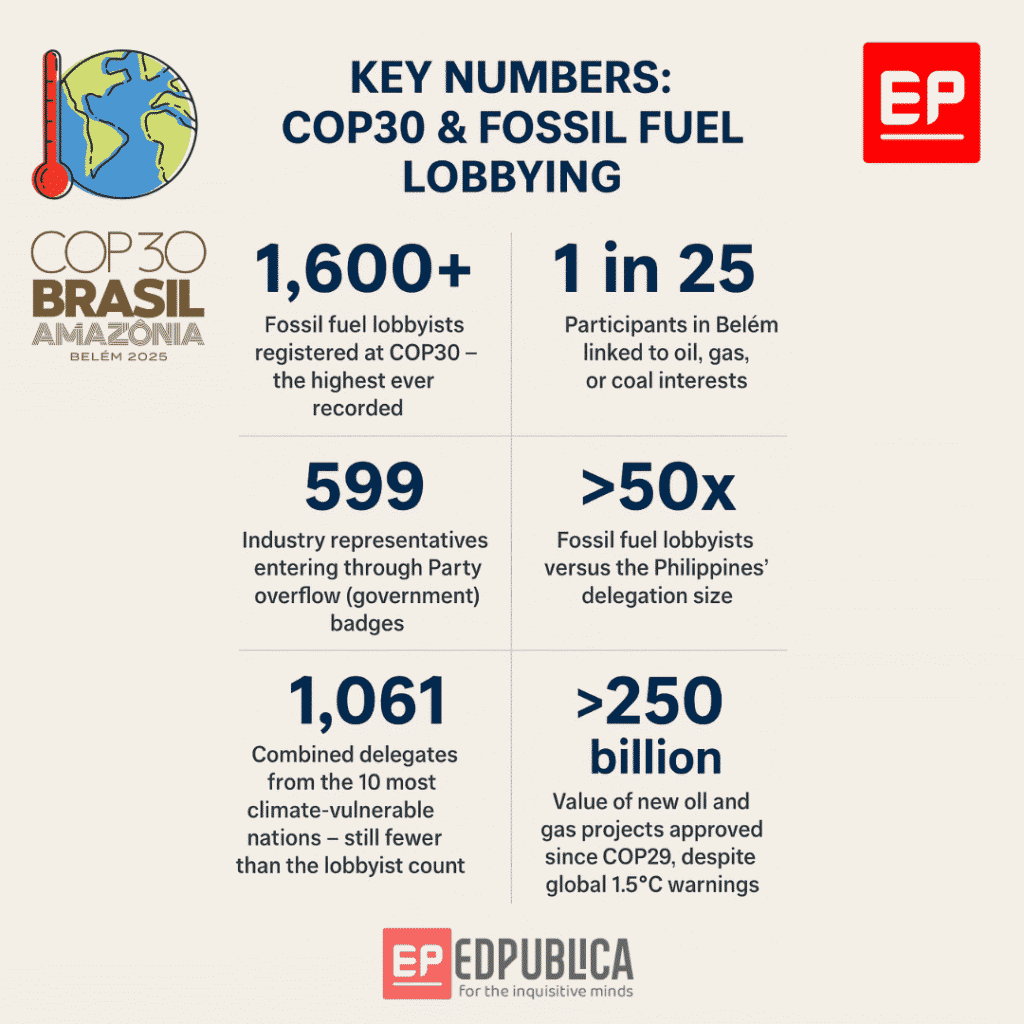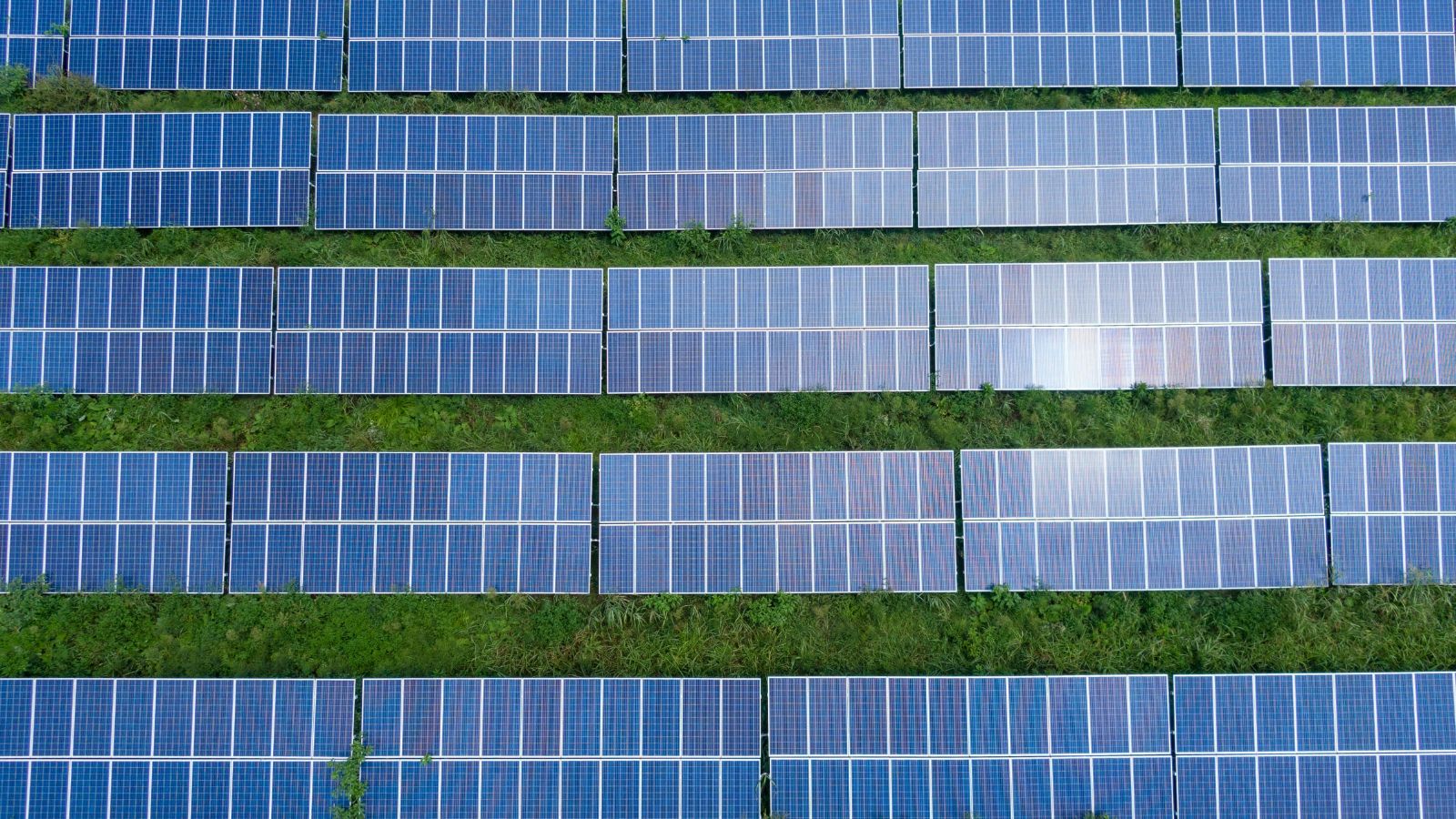COP30
Corporate Capture: Fossil Fuel Lobbyists at COP30 Hit Record High, Outnumbering Delegates from Climate-Vulnerable Nations
COP30 sees over 1,600 fossil fuel lobbyists inside climate talks, surpassing delegations of climate-vulnerable nations. Experts warn of corporate capture.

COP30 was billed as the “Implementation COP,” a summit where governments would finally convert years of climate promises into concrete action. Instead, the year’s most striking headline comes from the corridors, not the negotiation rooms: more than 1,600 fossil fuel lobbyists have entered the talks — the highest in the history of the UN climate process.
A new analysis by the Kick Big Polluters Out (KBPO) coalition reveals that one in every 25 participants in Belém is linked to the oil, gas, or coal industry. The number surpasses the total delegations of many climate-vulnerable nations and even outnumbers the combined negotiating teams of the 10 most climate-impacted countries.
For many observers, the surge represents not just a statistic but a symptom of a deeper structural crisis.
“It’s common sense that you cannot solve a problem by giving power to those who caused it,” said Jax Bonbon of IBON International in a statement. “Yet three decades and 30 COPs later, more than 1,500 fossil fuel lobbyists are roaming the climate talks as if they belong here.”
A Climate Summit Outnumbered by Industry
The analysis shows 599 industry-linked representatives entered COP30 through Party overflow badges — a route typically reserved for government delegates. This method bypasses new transparency rules that require non-government participants to disclose their affiliations.

Several countries also included fossil fuel representatives directly within their official delegations. According to the report, France, Japan, and Norway brought senior industry figures, including those from TotalEnergies, Japan Petroleum Exploration, and Equinor.
“Until we Kick Big Polluters Out, we can expect the outcomes of COP30 — and every COP after — to be written by the world’s largest polluters,” said Pascoe Sabido of Corporate Europe Observatory. “It’s profit over people and the planet.”
The contrast between industry presence and the representation of climate-impacted nations is stark. The Philippines’ delegation is outnumbered by nearly 50 to 1. Jamaica sent fewer than 40 delegates — as it deals with the aftermath of Hurricane Melissa — while hundreds of industry lobbyists move freely inside the venue.
‘A Flood of Influence’
Civil society groups warn that the negotiations risk being shaped by the very actors accelerating the climate crisis.
“The COP is massively flooded with around 1,500 representatives of the fossil fuel industry — like a river bursting its banks and sweeping everything away,” said Susann Scherbarth of Friends of the Earth Germany.
The criticism echoes growing frustration among scientists and youth groups over the widening gap between climate science and political outcomes. Despite repeated warnings from the IPCC about the need for rapid fossil fuel phase-down, nearly $250 billion worth of new oil and gas projects have been approved since COP29.
Youth delegations expressed alarm that the negotiation space is becoming increasingly inaccessible to those most affected by the climate crisis.
“The UNFCCC is in need of rehabilitation,” said Pim Sullivan-Tailyour from the UK Youth Climate Coalition. “My generation deserves Just Transition policies shaped by what people and the planet need — not what polluters’ profits demand.”
Demands for Integrity and Accountability
Transparency and governance experts argue that the situation has reached a defining moment. “If COP30 is indeed the COP of truth, the Presidency and the UNFCCC Secretariat must strengthen participant disclosure rules,” said Brice Böhmer of Transparency International. “It is time to ensure integrity and restore trust.”
Civil society groups are urging governments to adopt formal conflict-of-interest rules, a step the UNFCCC has so far resisted. They argue that genuine climate progress requires insulating negotiations from actors whose core business models rely on continued fossil fuel extraction.
A Crossroads Moment for the UN Climate Process
COP30 was expected to accelerate global action toward limiting warming to 1.5°C. Instead, it has reopened a fundamental question: Can a climate summit deliver meaningful outcomes when the world’s largest polluters enjoy unprecedented access inside the process?
The KBPO coalition says the answer depends on whether the UNFCCC is willing to adopt structural reforms that prioritise vulnerable communities over powerful corporations.
As the talks continue in Belém, the tension between ambition and influence remains at the heart of COP30 — raising critical questions about transparency, accountability, and the future of global climate governance.
COP30
From 6% to 16%: The Philippines Shows the World How Fast Climate Budgets Can Shift
In just four years, the Philippines has expanded its climate spending from PHP 282 billion to over PHP 1 trillion — one of the fastest fiscal shifts anywhere in the world.

Governments across the world are beginning to rethink the way national budgets are designed, moving away from traditional fiscal planning and toward systems that integrate climate considerations directly into spending decisions. A new comparative review of global green-budgeting practices reveals a trend that is gathering momentum: more countries are using their budgets as climate-governance tools. But the pace of progress varies sharply between advanced economies and emerging markets.
The Rise of Climate-Conscious Budgets
Countries such as France, Ireland, Mexico and the Philippines provide some of the clearest examples of how climate priorities are reshaping national expenditure. France has increased its identified climate-positive budget from €38.1 billion in 2021 to €42.6 billion in 2025, while Ireland expanded its environmental allocations from €2 billion (2020) to €7 billion (2025). Mexico’s transformation has been even more rapid: climate-related expenditures rose from MXN 70 billion (2021) to MXN 466 billion (2025) — a six-fold increase.
A Sudden Surge in the Philippines
Nowhere is the shift more dramatic than the Philippines. After embedding climate budget tagging across its ministries, the country’s climate budget expanded from PHP 282 billion in 2021 to more than PHP 1 trillion in 2025, raising its share of the national budget from 6% to 16%. The reform forced ministries to assess thousands of programmes through a climate lens, resulting in a shift toward resilient infrastructure, sustainable energy, water security, and climate-smart industries.
Advanced Economies Move Beyond Tagging
While emerging economies are scaling up climate allocations, advanced economies are integrating climate metrics deeper into fiscal systems. Canada’s “climate lens” requires greenhouse-gas and resilience assessments for major infrastructure projects before funding is approved. Norway links its annual budget to its Climate Change Act and long-term low-emission strategies. Germany uses sustainability indicators to guide fiscal decisions, embedding climate considerations into macroeconomic planning.
These tools go beyond transparency. They force ministries to justify public spending not only in economic terms, but in climate terms — shifting budgets from accounting documents to steering instruments.
Despite this momentum, the analysis notes a persistent gap: many countries stop at tagging climate-related expenditures without linking them to outcomes or performance indicators. Tagging improves transparency, but on its own does not change investment decisions. Without climate-based appraisal and monitoring, high-emission infrastructure can still slip through national budgets unchallenged.
The Financing Challenge
For lower-income countries, the largest barriers are financial. High capital costs, limited fiscal room, and weaker public financial management systems restrict the scale of green budgeting reforms. Even when climate spending rises, sustaining these increases requires integrating climate metrics into medium-term fiscal frameworks — something only a handful of emerging economies have attempted.
Innovations Show What’s Possible
Some models offer a blueprint. Indonesia’s climate-tagging system feeds directly into its sovereign green sukuk framework, giving investors clear visibility over the use of proceeds. This loop — tagging, reporting, financing — demonstrates how governments can leverage green budgeting to unlock larger pools of private capital.
Still in Progress
The report concludes that the next frontier for green budgeting is integration: linking budget tagging, climate-lens project appraisal, performance-based reporting, and climate-aligned fiscal strategies. Done together, these tools allow budgets to become climate-governance instruments capable of guiding national transitions.
But the pace remains uneven. Some countries are racing ahead, while others are taking incremental steps. What is clear, however, is that climate-aligned public finance is no longer optional. As climate impacts intensify, the alignment of the world’s budgets will determine who adapts — and who is left behind.
COP30
Clean Energy Push Could Halve Global Warming by 2040, New Analysis Shows
A new Climate Action Tracker analysis shows that tripling renewables, doubling energy efficiency and cutting methane could halve global warming by 2040

A rapid global shift to renewable energy, energy efficiency and methane cuts could halve the rate of global warming by 2040, dramatically altering the world’s climate trajectory, a new Climate Action Tracker (CAT) assessment finds.
The analysis shows that implementing the three core COP28 energy and methane goals—tripling renewable energy capacity, doubling energy efficiency improvements, and delivering steep methane cuts by 2030—would bring down projected warming from the current 2.6°C to 1.7°C by the end of the century.
Crucially, these actions would sharply slow near-term warming, reducing the pace of temperature rise by a third by 2035 and nearly half by 2040, compared to today’s rate of ~0.25°C per decade. This slowdown is critical not just for long-term climate goals but for immediate survival, the report stresses.
A Turning Point
The world is already struggling to cope with accelerating climate impacts. With ecosystems collapsing faster than species can adapt and communities facing worsening heatwaves, storms and crop failures, “catching up” on adaptation has become a global emergency.
CAT warns that under current policies, warming could continue rising throughout the century, leaving governments perpetually behind on adaptation planning. But halving the warming rate would give both people and ecosystems a fighting chance to adjust.
A 0.9°C Improvement in the Global Outlook
If all countries implement the three goals, the resulting emission cuts—14 GtCO₂e by 2030 and 18 GtCO₂e by 2035—would reduce expected warming this century by 0.9°C, one of the most significant improvements since the Paris Agreement.
“This is the single biggest step governments can take this decade, using goals they have already negotiated and agreed to,” the report notes.
Where the Reductions Come From
- Tripling renewables: ~40% of total emission reductions
- Doubling energy efficiency: ~40%
- Methane cuts: ~20%, but delivering disproportionate warming benefits due to methane’s strong short-term impact
Finance Is the Missing Link
The report underscores that technology is not the barrier—finance is. Many emerging economies cannot deploy renewables or upgrade grids at the necessary pace without scaled-up international support.
Still, the authors say the pathway is feasible and grounded in technologies already available at commercial scale.
While the world is almost certain to overshoot 1.5°C by the early 2030s, the duration and magnitude of that overshoot will determine future levels of loss and damage. Delivering the COP28 energy and methane goals, the report concludes, is the most powerful tool the world currently has to limit that overshoot and avoid runaway climate impacts.
COP30
Health Systems ‘Unprepared’ as Climate Impacts Intensify, Experts Warn at COP30
India will require $643 billion between now and 2030 to adapt to climate change under a business-as-usual scenario

On Health Day at COP30 (November 13), global health and climate experts warned that the world is dangerously underprepared for the accelerating health impacts of climate change, calling for a dramatic scale-up of adaptation finance to protect vulnerable populations.
Speaking at a press conference hosted by Regions4, the Global Climate & Health Alliance and CarbonCopy, leaders from research institutions and national governments said climate-linked health threats — from extreme heat to wildfire smoke — are rising sharply while funding remains “colossally” insufficient.
“Each year, more than half a million lives are lost due to heat, and over 150,000 deaths are linked to wildfire smoke exposure,” said Dr. Marina Romanello, Executive Director of the Lancet Countdown. “Health systems, already stretched and underfunded, are struggling to cope with these growing pressures, and most are still unprepared for what is coming.”
Romanello added that despite the scale of the crisis, “only 44% of countries have costed their health adaptation needs, and existing finance falls short by billions. Without urgent investment, we will not be able to protect populations from escalating climate impacts.”
Adaptation gap continues to widen
The speakers described health-sector underfunding as a critical part of the broader adaptation finance gap. The latest UNEP Adaptation Gap Report estimates developing countries will need $310–365 billion annually by 2035, while the international community is still struggling to mobilise even the $40 billion Glasgow Pact Goal.
“With regards to finance, the reality is that we have a deficit that is quite colossal,” said Carlos Lopes, Special Envoy for Africa, COP30 Presidency. “Most of the efforts are from national authorities. What we need from international finance is that it must be complementary.”
Lopes cautioned that climate and health policy still operates in “multiple contested layers,” warning that unless these are aligned, “we risk losing coherence in our global response.”
Countries highlight urgent needs
Representatives from Bangladesh, Nigeria, India and Chile echoed concerns that adaptation finance is far from matching on-ground needs.
“Our adaptation financing for health is far below what is needed. The gap between what we require and what we receive is enormous,” said Md Ziaul Haque, Additional Director General, Ministry of Environment, Bangladesh. He urged multilateral finance entities to bring forward “concrete, holistic proposals that match the scale of the challenge.”
Nigeria’s challenges are equally stark. “In Nigeria, we are facing an additional 21% disease burden due to climate change… yet the adaptation finance we received in 2021–22 only met 6% of our needs,” said Oden Ewa, Commissioner for Special Duties and Green Economy Lead. He called adaptation finance a “lifeline that saves lives, strengthens communities, and protects economies.”
India outlines its adaptation burden
India also presented updated estimates of its climate adaptation needs. “India will require $643 billion between now and 2030 to adapt to climate change under a business-as-usual scenario,” said Dr. Vishwas Chitale of the Council for Energy, Environment & Water. He noted that India has already made “significant progress, spending $146 billion in 2021–2022 alone — 5.6% of GDP.”
New funding coalition signals momentum
Speakers highlighted the launch of the Climate and Health Funders Coalition, which has committed an initial $300 million annually.
“This is an encouraging signal… It shows that the world is beginning to recognise that protecting health must be at the centre of climate adaptation,” said Jeni Miller, Executive Director, Global Climate & Health Alliance.
Health at the centre of adaptation
Chile stressed the need for integrated policy approaches.
“It is vital to combine the efforts of different ministries — not only health but also transport, energy and food production — so that we generate co-benefits across sectors,” said Dr. Sandra Cortes, President of Chile’s Climate Change Scientific Committee. “A more integrated approach will allow us to improve public health, reduce emissions and create fairer, more sustainable development opportunities.”
As negotiators continue discussions in Belém, experts reiterated that adaptation finance — especially for health — must be just, equitable, accessible and prioritise the most climate-vulnerable nations. The recently proposed Belém Health Action Plan and the Global Goal on Adaptation are expected to serve as frameworks for strengthening health system resilience worldwide.
-

 Know The Scientist5 months ago
Know The Scientist5 months agoRemembering S.N. Bose, the underrated maestro in quantum physics
-

 Space & Physics4 months ago
Space & Physics4 months agoJoint NASA-ISRO radar satellite is the most powerful built to date
-

 Society5 months ago
Society5 months agoShukla is now India’s first astronaut in decades to visit outer space
-

 Space & Physics4 months ago
Space & Physics4 months agoNew double-slit experiment proves Einstein’s predictions were off the mark
-

 Society6 months ago
Society6 months agoAxiom-4 will see an Indian astronaut depart for outer space after 41 years
-

 The Sciences5 months ago
The Sciences5 months agoHow a Human-Inspired Algorithm Is Revolutionizing Machine Repair Models in the Wake of Global Disruptions
-

 Society6 months ago
Society6 months agoWhy the Arts Matter As Much As Science or Math
-

 Earth6 months ago
Earth6 months agoWorld Environment Day 2025: “Beating plastic pollution”





































